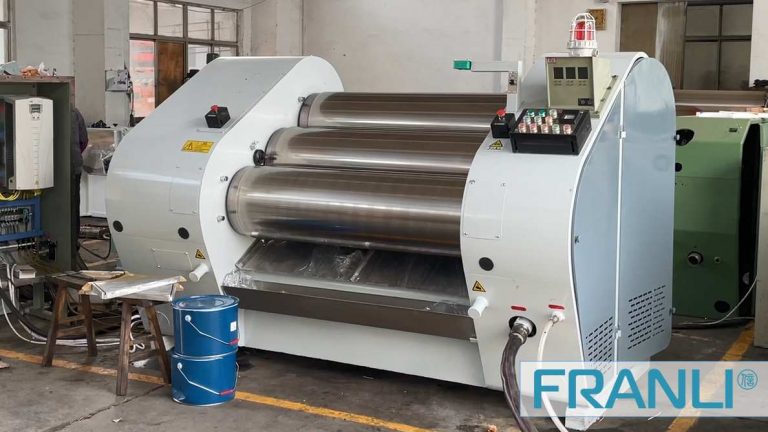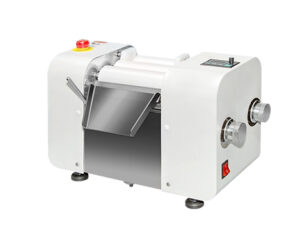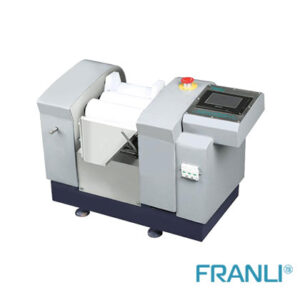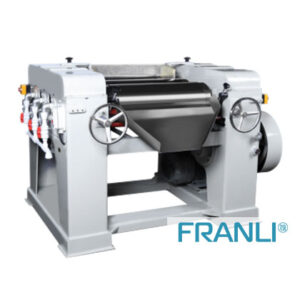Home » Three Roll Mill for Photovoltaic Silver Paste
Three Roll Mill for Photovoltaic Silver Paste
TRL 120/80 Three Roll Mill
Three-roll mills have become a critical process in the photovoltaic industry, especially for refining and homogenizing silver paste.
Details of Three Roll Mill
- Pressure mode
- Clearance mode
- Dual spacing control mode
- High level of operation safety
- Operation data (formula) can be stored
- Easy and convenient cleaning
- Simple roll pitch adjustment
- Selection of various roller materials
- Selection of various scraper materials
- Constant pressure contact of scraper
- Complete ceramic structure
- Parallel roll distance
- Speed control
- Water cooling
- Touch screen control
The photovoltaic industry has been growing rapidly with increasing demand for solar cells across the world. Solar cell production involves many processing steps, including the deposition, firing, and patterning of metallic pastes onto the solar cell surface. Silver paste plays a crucial role in this process as it forms the electrical contacts on the solar cell surface, which ultimately makes the electricity flow out of the cell. The performance and efficiency of solar cells depend on the quality and uniformity of the silver paste. Therefore, refining and homogenizing silver paste has become critical in the photovoltaic industry, and this is where three-roll mills come into play.
What is a three-roll mill?
A three-roll mill is a machine that uses three horizontally positioned rollers to homogenize materials and reduce particle size. The rollers rotate at different speeds and generate high shear forces to disperse and refine the materials passing through them. The distance between the rollers, also known as the roller gap, can be adjusted to control the particle size and consistency of the final product. The machine can be controlled manually or through hydraulic or electronic systems.
Benefits of three-roll mills for photovoltaic silver paste
Three-roll mills offer several benefits for refining and homogenizing photovoltaic silver paste, such as:
1. Uniformity: The three-roll mill’s high shear forces work to break down and disperse aggregates or clumps of particles, ensuring uniformity in the silver paste. A uniform silver paste layer on the solar cell surface improves the cell’s performance and efficiency.
2. Consistency: The adjustable roller gap allows for precise control over the particle size and consistency of the silver paste. The machine can produce a consistent paste with tight particle size distribution, reducing the variation in the firing and conductivity characteristics of the silver paste.
3. High Processing Efficiency: The three-roll mill can process a large amount of silver paste in a short time, making it ideal for high-volume production environments. The efficient process results in less downtime and increased productivity.
4. Cost-Effective: Three-roll mills offer a cost-effective solution to refine and homogenize silver paste with low maintenance, repair, and replacement costs.

Operating principles of three-roll mills
The operating principles of three-roll mills for refining and homogenizing photovoltaic silver paste are simple. The paste is fed into the gap between the rollers, and high shear forces are applied to break down and disperse the aggregates or clumps of particles. The rollers’ speed and gap distance controls the degree of particle size reduction. The finely dispersed silver paste is then collected on the third roller and transferred to a container for further processing.
Important considerations while using three-roll mills for photovoltaic silver paste
Photovoltaic silver paste is a sensitive material and requires some important considerations while using three-roll mills for refining and homogenizing it.
1. Roller Material: The roller material choice will depend on the silver paste’s sensitivity to contamination and the desired particle size. Common roller materials include ceramic, tungsten carbide, chilled iron, stainless steel, and composites.
2. Roller Gap: The roller gap should be adjusted to control the particle size and consistency of the silver paste. A tighter gap results in finer particle size, but too tight a gap results in roller wear and tear, and too loose a gap leads to coarse particles.
3. Agitation: The silver paste should be thoroughly mixed and stirred before feeding into the three-roll mill to ensure a consistent paste feed to the rollers.
4. Cleaning: The machine must be cleaned regularly to prevent contamination of the silver paste and ensure consistent performance. The cleaning schedule should be strictly followed, and specialized cleaning products should be used.
Three-roll mills have become a critical process for refining and homogenizing photovoltaic silver paste used in solar cell production. The high shear forces generated by the rollers ensure uniformity and consistency in the silver paste, improving the cell’s performance and efficiency. The machine’s efficiency, cost-effectiveness, and precise control of particle size and consistency make it a popular choice for high-volume production environments. Understanding the operating principles and important considerations while using three-roll mills for photovoltaic silver paste is crucial to ensure optimal performance and consistent results.
FRANLI manufactures all types of three roll mills and designs the best solutions for different materials. As a three roll mill manufacturer with 20 years of experience, FRANLI has a team of experts in the design of a complete line and provides permanent pre-and post-sales service.
Welcome to send inquiry to us and let’s make a win win business together !
Guidelines For Three Roll Mill
Three roll mills are widely used in a variety of chemical industries, from medium to high viscosity productions. FRANLI machine can break open all kinds of pigment, UV ink, offset ink, decorative paints, and Lubricants, it also can catch the greatest fineness in cosmetics/ lipstick and electronics industries.

Three Roll Mill For Carbon Black|High Grinding & Dispersion
Three roll mill is the main equipment for grinding colored carbon black, as it is used extensively in rubber, plastics, paints, and inks, and some carbon black is added.

Laboratory Three Roll Mill|PLC Control System & Experimental
The laboratory three roll mill is equipped with the most advanced PLC functions to continuously improve the operability of the most primitive production equipment.

Three Roll Mill For Grease
The three roll mill plays a vital role in the grinding of grease. Grease is essentially a kind of lubricating oil, which is a solid or semi-solid product formed by one or more thickeners through the grinding and dispersing action of a three roll mill.

Three Roll Mill For Attapulgite
Three roll mill is the main equipment for grinding attapulgite. The attapulgite is ground and dispersed mainly because it is a natural colloid. Even if the size of the attapulgite reaches 0.1mm, it cannot be easily dispersed by the machine, so the final state of attapulgite formation has been greatly developed.

Rolls of a three-roll mill
The three-roll mill is mainly used for grinding materials of various viscosities and is one of the best wet grinding equipment. The dispersing and emulsification effect of the three-roll mill is excellent, especially for ink, paint, colloid, chocolate, plastic, cosmetics, etc., whether it is liquid slurry or paste material, the three-roll mill can work easily.

3 roll mill|Failure of the roll shaft & pulley
The 3 roll mill is a grinding and dispersing equipment, which plays an irreplaceable role in improving the quality of coating products.

